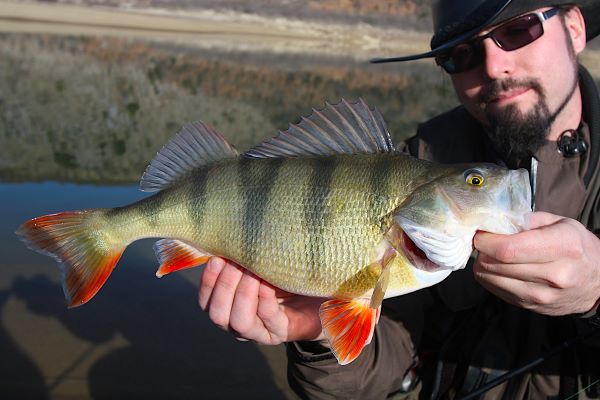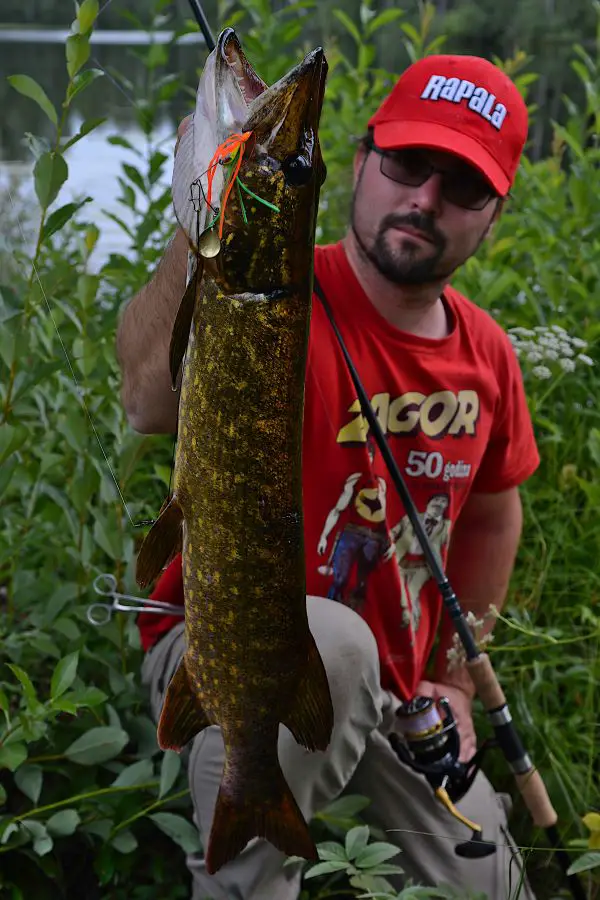Disclosure: Some posts contain affiliate links, which earn us a commission if you make a purchase through them. Positive Fishing © participates in various affiliate networks including the Amazon Services LLC Associates Program.
Are you interested in trying the exciting world of pike or perch fishing? And possibly not certain where and how to start?
Well, you are in the right place! This pike and perch fishing article will help beginners and youngsters learn the skills and know-how to catch some of these incredible predator fish.
I have spent numerous years fishing for these two species and will gladly share some of my experience to help you master the first steps of successful pike and perch fishing.
Perch Fishing

A big advantage of taking on the perch game is the numbers you have at your disposal. Perch is not a solitary fish. If there are perch in the water of your choice, there are very likely many of them!
Half of the job is already done if you learn where to find them. And when it comes to fishing for them, the fun will be endless!
Where To Find Perch?
This should be a rather simple task if you are fishing on a river. If you are planning on fishing in a lake, it’s even easier!
Perch avoid dwelling in fast-flowing water and stick to the river’s slow-moving parts. At the same time, they are always near some cover providing shade and ambush points.
Rivers could include river bends, grass patches near the bank, rock formations providing cover, sunken trees, etc.
In lakes, perch are often scattered and present in nearly every type of habitat. But you will always find them hiding in underwater grassy areas or under lily pads. Drop-offs and underwater formations (trees, rocks, or anything else) are also hot spots you should search for!
Suppose some tiny fish are swimming about the chosen spot – even better! Perch will surely be around, as these fish are most likely their primary food source.
How To Fish For Perch?
Fishing for perch can be performed either using baits or lures.
Bait fishing is considered to be easier and more beginner-friendly. Lure fishing offers much more adrenaline and fun but is also more demanding.
I will cover both types of fishing and let you decide what suits you best!
Bait Fishing For Perch
The simplest and most effective way of bait fishing is using a simple float rig and various types of earthworms.
You need a float road (I personally prefer a match rod of around 4.20 m in length) and a size 3000 spinning reel spooled with a 0.20 mm monofilament line. The weight of the float can vary depending on the water type: a 2-3 g weight float can be more than enough for a lake, but you will need to scale up for rivers.
40 cm hook length made of 0.18 mono coupled with a hook ranging from #2 to #8 is the rig of choice. You will need some lead shots to balance the float and be ready to fish!
Earthworms can be used as a single worm, but if small, you can string a few of them together onto your hook. You can learn more in-depth information in my article on how to fish with worms, including special tips and insights from my personal experiences.
Adjust your depth so that you are within 0.5 m of the bottom, and start searching the water by casting your float close to previously described spots. If perch are there, they will take your bait in no time!
To have more chances of successful fishing, try hitting the water early in the morning or during the late evenings. If the weather is overcast, you can go fishing any time of the day!
Lure Fishing For Perch
Lure fishing enables you to cover a lot of water in a short time span! Therefore, it is perfect for searching for new fishing spots.
If you are starting with lure fishing for perch, it is best to do so with an ultra-light setup. A spinning rod with casting weight up to 7 g, 2000-2500 size reel, thin braid (PE 0.6), and a meter of 0.16 mm fluorocarbon line is the perfect combo set-up for perch fishing adventures!
It is best to stick with the simplest solution when choosing your lures. A choice of small silicone grubs or shads in the 1-3” range, combined with appropriate small jig heads ranging from 1-5 g, will be more than enough to have a nice fishing day.
When choosing which colour lures to use, always follow the watercolour rule – if the water is clear, use natural colours; if the water is murky, go with bright, flashy colours. To start, chartreuse, white, and pearl-green lures should be more than sufficient!
Lure fishing for perch can be described as hopping along the bottom. Perch are bottom-dwelling fish; therefore, the bottom is the place to search for them!
Try casting your lure somewhere in the vicinity where you expect the perch to be, and let it sink to the bottom. Now, you need to produce a series of jumps from the bottom, getting the attention of the perch, each time letting your lure sink back down. As a general rule, perch will take the lures more in the fall!
This technique is called jigging and is the most common way of fishing with silicone baits. Mastering it on perch is a perfect starting point for advancing to other species like pike or especially zander!
Another fantastic and easy method to catch perch is fishing with the drop shot rig. This is a tried and tested method for these smaller predators and will always bring success, whatever the time of year.
Pike Fishing

Fishing for pike is a big level up from perch fishing. These predators will grow much bigger than perch and are also incredibly aggressive. It takes some skill to land your first pike successfully!
To do so, you need to learn how to read the water and assemble your tackle to prepare it for a fight with pike. You can learn more about choosing the essential rod, reel, and key accessories for catching these tremendous predator fish.
Where To Find Pike?
Firstly, try avoiding big, especially faster-flowing rivers. These waters hold pike but are very tough fishing grounds for beginners.
Instead, focus on smaller rivers and lakes. Pike hunt from ambush positions; it can be very easy to locate them if the water is not too big!
For example, is there a sunken tree in the water? If yes, there is most likely a pike under it! Is there a small bay covered in lily pads? Well, there ought to be some pikes under them! The same goes for drop-offs, grassy shallows, reed belts, structures such as peers, etc.
With some experience, you will learn to recognize pike spots simply by looking closely at the water!
How To Fish For Pike?
Pike are most commonly targeted with lures due to the high adrenaline experience this fishing technique offers.
You can also target pikes with live bait or dead bait. This method is easier to do than lure fishing but is not as exciting as repeatably casting out and retrieving your lure, waiting for a pike to come out from nowhere and snatch your bait!
Bait Fishing For Pike
First, you need live bait. You can either purchase them from the local supermarket or use a light float set up to fish for some small roach, rudd, or chub.
Then, it would be best to have a stronger, at least 3 m long rod that can cast a 100g rig to a sufficient distance. Couple it with a size 4000-5000 reel, and spool it with a 0.35mm or 0.40mm monofilament line.
Making a live bait float rig might be a bit of a challenge – luckily, there are ready-made float rigs available for purchase, which is an excellent option for beginners!
When you are all set, you only have to cast your rig in a good spot and wait. When a pike approaches your bait, the float will begin to tremble – this means the fish is trying to get away from the predator. When it goes underwater, you have a strike! However, you will need to wait for a while, as the pike needs to adjust the bait in its mouth and start swallowing. This is known as a second run – the float will most likely circle a bit after first sinking and then go underwater again. And this is then the exact time to set the hook!
Lure Fishing For Pike
At the moment, lure fishing for pike is by far the most trending fishing technique in Europe. Pike will respond to various lures, hit the lure with immense aggression, and put up a hell of a fight! Coupled with the respectful size they can achieve, it is easy to understand why pike fishing is a bright spot in the fishing industry.
To start your pike fishing journey from new, you must assemble a basic pike spinning setup.
You will be fine with a medium-heavy rod with a fast action for most waters. 2.7m is the length to go for waters with enough room for you to cast correctly. If there are a lot of tree overhangs, consider using a shorter 2.4 m rod. Coupled with a 4000-sized reel spooled with a PE rating of 1.2 mm or 1.4 mm braided fishing line, you are good to go!
There are only two more things you need: Wire leaders and, of course, multiple lures.
Wire leaders are essential due to the toothy jaws pike possesses. Pike will probably cut your monofilament or even braided line off. You can make your own, but for a start, it is easier to purchase some ready-made pike wire leaders. They are easy to find!
Now, the lures. You do not need to spend much money on hundreds of various lures. I highly recommend you use a few of the Mepps Aglia size #3 – #5 spinners and a couple of 15-40 g spoons (bright or silver for clear water and a gold or brass spoon for murky water) to get you going. If the water is grassy, a simple spinner bait such as the Mepps Aglia is a perfect solution!
All of these lures are very simple to use. They can be fished with a straight retrieve or with stop-and-go variations that will enable you to search through the different depths of the water layer. Since pike likes to be near cover and obstructions, you will find it nearly impossible to avoid getting snagged, but this is also an important part of the learning process for beginners!
Final Thoughts
Both perch and pike fishing is constantly evolving, with numerous fishing techniques being used, adapted, and changed every day.
This article hopefully has given you an insight into the basics of pike and perch fishing, but it is up to you to keep exploring the options and find your way of becoming a master!
Practice makes perfect!
Check out my other relevant articles on choosing the best treble hooks for catching predatory fish and fishing with the top choice baits and lures for predator fish, which will help you learn even more about the art of catching all types of these toothy critters!
- Winter Lure Fishing For Catching Zander In Rivers & Lakes - January 22, 2022
- What Is Bolognese Fishing? The Ultimate Guide To Bolo Fishing - December 29, 2021
- How To Catch Carp: The Best Carp Hookbaits Revealed - November 17, 2021

